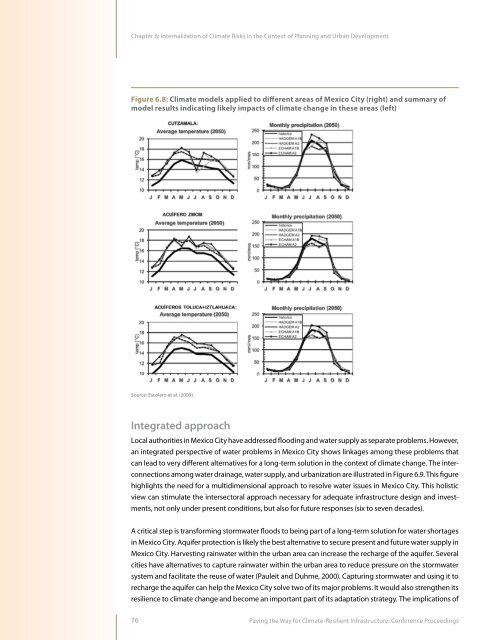Chapter 6: Internalization of <strong>Climate</strong> Risks in <strong>the</strong> Context of Planning and Urban DevelopmentFigure 6.8: <strong>Climate</strong> models applied to different areas of Mexico City (right) and summary ofmodel results indicating likely impacts of climate change in <strong>the</strong>se areas (left)Source: Escolero et al. (2009).Integrated approachLocal authorities in Mexico City have addressed flooding and water supply as separate problems. However,an integrated perspective of water problems in Mexico City shows linkages among <strong>the</strong>se problems thatcan lead to very different alternatives <strong>for</strong> a long-term solution in <strong>the</strong> context of climate change. The interconnectionsamong water drainage, water supply, and urbanization are illustrated in Figure 6.9. This figurehighlights <strong>the</strong> need <strong>for</strong> a multidimensional approach to resolve water issues in Mexico City. This holisticview can stimulate <strong>the</strong> intersectoral approach necessary <strong>for</strong> adequate infrastructure design and investments,not only under present conditions, but also <strong>for</strong> future responses (six to seven decades).A critical step is trans<strong>for</strong>ming stormwater floods to being part of a long-term solution <strong>for</strong> water shortagesin Mexico City. Aquifer protection is likely <strong>the</strong> best alternative to secure present and future water supply inMexico City. Harvesting rainwater within <strong>the</strong> urban area can increase <strong>the</strong> recharge of <strong>the</strong> aquifer. Severalcities have alternatives to capture rainwater within <strong>the</strong> urban area to reduce pressure on <strong>the</strong> stormwatersystem and facilitate <strong>the</strong> reuse of water (Pauleit and Duhme, 2000). Capturing stormwater and using it torecharge <strong>the</strong> aquifer can help <strong>the</strong> Mexico City solve two of its major problems. It would also streng<strong>the</strong>n itsresilience to climate change and become an important part of its adaptation strategy. The implications of76<strong>Paving</strong> <strong>the</strong> <strong>Way</strong> <strong>for</strong> <strong>Climate</strong>-<strong>Resilient</strong> <strong>Infrastructure</strong>: Conference Proceedings
Chapter 6: Internalization of <strong>Climate</strong> Risks in <strong>the</strong> Context of Planning and Urban DevelopmentPART IIthis approach <strong>for</strong> <strong>the</strong> design and funding of infrastructure are significant. Current funding is only orientedto maintain <strong>the</strong> operation of <strong>the</strong> current drainage system. Mexico City would need to consider creatingseparate systems <strong>for</strong> sewage and <strong>for</strong> stormwater to facilitate <strong>the</strong> recharge of <strong>the</strong> aquifer. Treated sewagecould also be used to recharge <strong>the</strong> aquifer. This strategy is already part of sustainable urban planning ino<strong>the</strong>r major urban areas in <strong>the</strong> world.TechnicalPresentation 1What a Country ShouldThink About andThen Do to Address<strong>Climate</strong> Change and<strong>Infrastructure</strong> RisksA number of o<strong>the</strong>r actions are necessary to streng<strong>the</strong>n <strong>the</strong> long-term sustainability of Mexico City. Forexample, <strong>the</strong> use of ecosystem services can also help alleviate conditions within <strong>the</strong> urban area and buildresilience to <strong>the</strong> negative impacts of climate change. The use of vegetation within <strong>the</strong> urban area canalleviate <strong>the</strong> impact of <strong>the</strong> heat island effect, reduce <strong>the</strong> demand of energy and water, and increase <strong>the</strong>index of com<strong>for</strong>t to higher temperatures. It is important that discussions and debate take place to plan <strong>the</strong>future of <strong>the</strong> city within <strong>the</strong> context of climate change.TechnicalPresentation 2Internalization of<strong>Climate</strong> Risks in <strong>the</strong>Context of Planningand Urban DevelopmentUn<strong>for</strong>tunately, Mexico City has not initiated a serious debate about its future sustainability. Although <strong>the</strong>city has an adaptation plan to climate change (published in 2009), <strong>the</strong> plan has a significant imbalancebetween mitigation and adaptation measures. There are 29 mitigation actions (costing 56,152,000 millionpesos) in <strong>the</strong> <strong>Climate</strong> Action Plan compared to 12 adaptation actions (costing 2,998,000 million pesos).About 95 percent of <strong>the</strong> climate change budget is allocated to mitigation ef<strong>for</strong>ts ra<strong>the</strong>r than to adaptation.Given <strong>the</strong> needs <strong>for</strong> adaptation in Mexico City, this emphasis should be inverted so that more of <strong>the</strong>budget is spent on adaptation. The <strong>Climate</strong> Action Plan does not consider <strong>the</strong> potential impacts of climatechange on floods or water supply as part of <strong>the</strong> adaptation needs in Mexico City.TechnicalPresentation 3A Framework <strong>for</strong>Risk Assessmentand Risk-In<strong>for</strong>medDecision-Making <strong>for</strong><strong>Infrastructure</strong>DevelopmentThese lessons are helpful <strong>for</strong> El Salvador, particularly <strong>for</strong> its capital city San Salvador, that faces similarproblems to those described above in Mexico City.Data from <strong>the</strong> last population census indicated that <strong>the</strong> metropolitan area of San Salvador had 1,566,629inhabitants. 10.4 percent of <strong>the</strong>m live in extreme poverty, and <strong>the</strong>y are located in hazardous areas along<strong>the</strong> ravines and rivers that run through <strong>the</strong> metropolitan area. However, exposure to flooding, erosion,and landslides extends to larger areas of San Salvador and a larger part of <strong>the</strong> population due to <strong>the</strong> lackof control of urbanization and constant modification of <strong>the</strong> landscape.Urban growth, driven by low- and high-income groups, has given little consideration to <strong>the</strong> flow and controlof stormwater within urban areas. Public authorities have not been able to orient <strong>the</strong> rapid process of urbanizationprotecting key physiographic conditions of <strong>the</strong> landscape allowing <strong>the</strong> flow of runoff during extremeclimatic events. There is no complete hydrological model <strong>for</strong> <strong>the</strong> metropolitan area of San Salvador, and <strong>the</strong>stormwater system is incomplete. Deficiencies in planning urban growth and its incomplete en<strong>for</strong>cementhave resulted in <strong>the</strong> reduction, modification, or blocked water flow in <strong>the</strong> rivers and ravines used as primarydrains <strong>for</strong> stormwater. The path of urbanization in San Salvador has created urban and social vulnerabilityto climatic events, which can be exacerbated by climate variability and climate change.The impact of recent tropical storms illustrates this point. <strong>Climate</strong> related hazards have become morefrequent as rapid urban growth has modified <strong>the</strong> landscape in San Salvador. Studies report flooding,erosion and landslides problems in several parts of <strong>the</strong> metropolitan area with precipitation higher than50 mm per hour. Using data from <strong>the</strong> meteorological station in San Salvador and its surrounding area,o<strong>the</strong>r studies estimate that <strong>the</strong>re is 50 percent chance that events with precipitation of 90 mm in 24 hoursoccur every year (Fernandez-Lavado, 2010).TechnicalPresentation 4Probabilistic RiskModeling: BasicPrinciples andApplicationsTechnicalPresentation 5An Economic Framework<strong>for</strong> Evaluating <strong>Climate</strong>Proofing Investmentson <strong>Infrastructure</strong>TechnicalPresentation 6Supporting ElSalvador to Reduce<strong>Infrastructure</strong> Riskswithin a Green, Low-Emission and <strong>Climate</strong>-<strong>Resilient</strong> Framework<strong>for</strong> Development<strong>Paving</strong> <strong>the</strong> <strong>Way</strong> <strong>for</strong> <strong>Climate</strong>-<strong>Resilient</strong> <strong>Infrastructure</strong>: Conference Proceedings 77
















